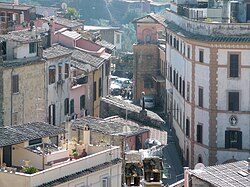Capena
| Capena | |
|---|---|
| Comune | |
| Comune di Capena | |

View down Via Fausto Cecconi
|
|
| Location of Capena in Italy | |
| Coordinates: 42°08′25″N 12°32′25″E / 42.14028°N 12.54028°ECoordinates: 42°08′25″N 12°32′25″E / 42.14028°N 12.54028°E | |
| Country | Italy |
| Region | Lazio |
| Province / Metropolitan city | Rome |
| Government | |
| • Mayor | Dr. Antonella Bernardoni |
| Area | |
| • Total | 29.5 km2 (11.4 sq mi) |
| Elevation | 160 m (520 ft) |
| Population (2009) | |
| • Total | 9,336 |
| • Density | 320/km2 (820/sq mi) |
| Demonym(s) | Capenati |
| Time zone | CET (UTC+1) |
| • Summer (DST) | CEST (UTC+2) |
| Postal code | 00060 |
| Dialing code | 06 |
| Patron saint | St. Luke |
| Saint day | October 18 |
| Website | Official website |
Capena (until 1933 called Leprignano) is a town and comune in the Metropolitan City of Rome, Lazio region (central Italy). The town has borrowed its modern name from a pre-Roman and Roman settlement that was 3 kilometres (1.9 mi) to its north.
The original Capena occupied the plateau of a nowadays uninhabited hill called La Civitucola. Its territory was known in ancient times as the Ager Capenas, which was a Faliscan area adjacent (and culturally allied) to Etruria. It is frequently mentioned alongside of Veii, Falerii and Lucus Feroniae.
Ancient Capena seems to have been ruthlessly sacked by the Romans sometime around 390 BC, following a long campaign of resistance by the Capenates to the ever-growing influence of Rome in the area. The settlement continued to exist until the collapse of the Western Roman Empire, after which all traces of it were lost. It was not until the pioneering work of Pierluigi Galletti in the mid-18th century that Capena’s former location was decisively identified. Even then, it took more than a hundred years for other historians to reach a consensus that Galletti had been correct.
Recent archaeological studies have revealed that ancient Capena may have retained a vibrant urban life and some degree of regional significance for longer than had previously been believed.
The site of present-day Capena has been inhabited intermittently since prehistoric times and archaeological finds dating from the seventh century BC indicate that the inhabitants used a distinctive alphabet (now called the Capena-Leprignano alphabet by philologists) for inscriptions written in the Faliscan language. Continuous habitation began in the 11th century AD, when the Benedictine monastery of Saint Paul – now usually referred to as the Palazzo dei Monaci (Palace of the Monks) – was established on the tuff outcrop known as ‘la Rocca’ (the Rock).
The main frontage of the palazzo faces the Piazza del Popolo, the largest public space in Capena. Originally simply called the ‘Piazza’, the square was laid out in the 16th century, when its extant clock tower was erected on the north side. The surviving monastery complex dates primarily from the Renaissance era, with extensive modifications in 1851.
...
Wikipedia

